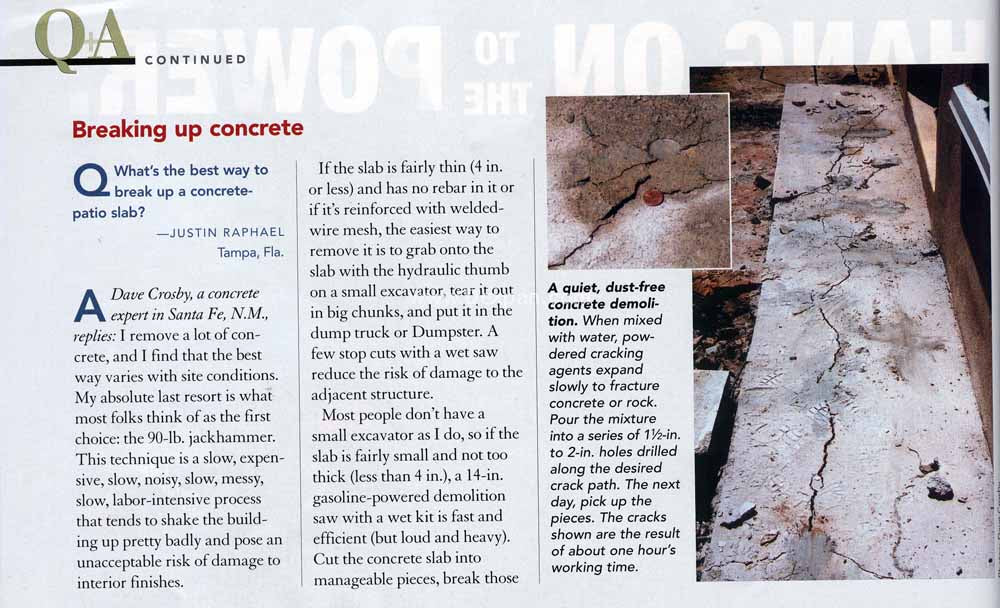What's the best way to break up concrete? | Dexpan Project M003 Photos
Fine Homebuilding Magazine, Oct-Nov 2005 Issue
Job done by DIY home user
See more Concrete Demolition Projects



Breaking up concrete
Q: What's the best way to break up a concrete patio slab?
- Justin Raphael, Tampa, Florida
A: Dave Crosby, a concrete expert in Santa Fe, NM replies:
I remove a lot of concrete, and I find that the best way varies with site conditions. My absolute last resort is what most folks think of as the first choice: the 90-lb. jackhammer. This technique is a slow, expensive, slow, noisy, slow, messy, slow, labor-intensive process that tends to shake the building up pretty badly and pose an unacceptable risk of damage to interior finishes.
If the slab is fairly thin (4 in. or less) and has no rebar in it or if it's reinforced with welded-wire mesh, the easiest way to remove it is to grab onto the slab with the hydraulic thumb on a small excavator, tear it out in big chunks, and put it in the dump truck or dumpster. A few stop cuts with a wet saw reduce the risk of damage to the adjacent structure.
Most people don't have a small excavator as I do, so if the slab is fairly small and not too thick (less than 4 in.), a 14-in. gasoline-powered demolition saw with a wet kit is fast and efficient (but loud and heavy). Cut the concrete slab into manageable pieces, break those pieces with a maul, and haul them out.
For thicker slabs or for when impact, vibration, noise, dust or any contamination is unacceptable, one solution is easy and fun: expansive cracking agents (for example, Bristar and Dexpan). These chemical powders are mixed with water and poured into 1-1/2 in. to 2 in. diameter holes drilled in the concrete. Over the next 24 hours, the agent expands with about 18,000 lb. per sq. in. of force. Breaking stone or concrete this way is clean, quiet, safe, controllable, and relatively inexpensive. I have used Dexpan to break a residential slab that was 15 in. thick at the center and 34 in. thick at the edges. The hardest thing I did that day was drill the holes with a rotary hammer. The next day, we picked up the pieces.
By placing the holes properly, you can shape the cracking and exercise a high degree of control over the process. These agents are relentless, though, so make sure there's a place for the concrete to expand into other that your house. If you pour them into a hole, something is going to break, and you don't want it to be your foundation.
A quiet, dust-free concrete demolition. When mixed with water, powdered cracking agents expand slowly to fracture concrete or rock. Pour the mixture into a series of 1-1/2 in to 2 in. holes drilled along the desired crack path. The next day, pick up the pieces. The cracks shown are the result of about on hour's working time.
